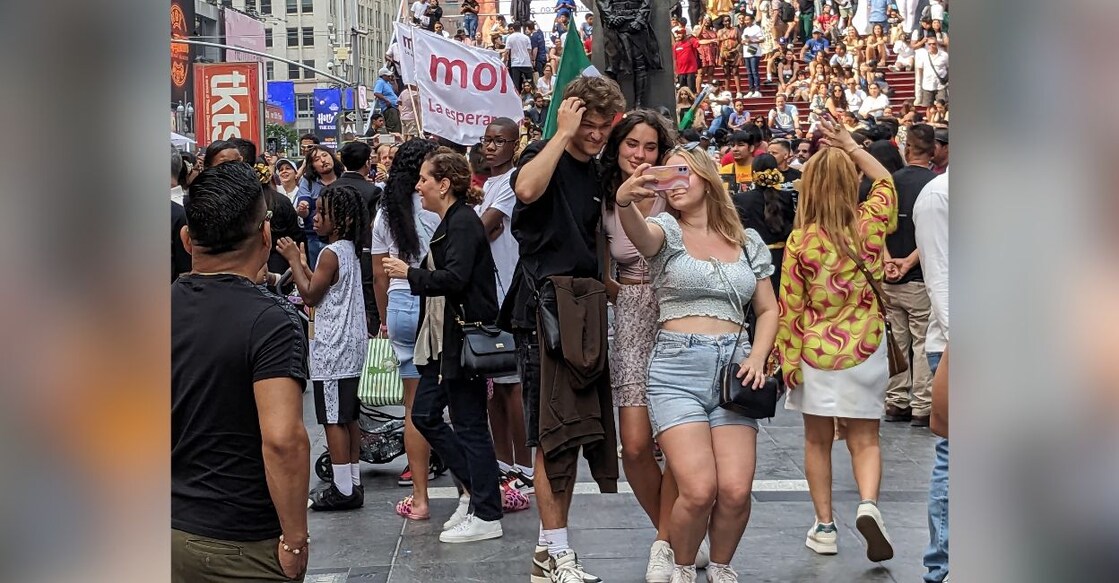A user’s manual for shoestring travellers to New York

Mail This Article
Many of you must’ve already discovered your own way of tackling New York as a shoestring traveler. There’s nothing revolutionary about my method. Two good friends helped me work this out. Manohar Thomas who has lived in New York for about 40 years and Sanjesh, an IT professional who lives in Austin but knows the city well.
I’ve been going to New York since 1988 but never managed to grasp even a fraction of what it was all about. Mine were short visits. Even a week was too short. But I didn’t let go. Thus, in the summer of 2023 I set apart nearly a month to the task of worming my way into the mysteries of New York. I wanted to understand it - if at all it’s possible to understand a metropolis of such magnitude. My investigations into New York had another purpose also: collect material and take pictures for a book on New York – which should hopefully be done soon.
New York demands patience. It demands time. Why take the trouble of understanding it at all? The answer is simple: it is an extraordinary human confluence, magnificent and awe-inspiring in its design. Spell-binding and imposing. Splendid and glittering. It can scare the wits out of you by its sheer majesty – the towering heights, the ramifications of the wandering streets and the melting pot of people in which you find yourself. And the subways that thunder beneath your feet. It is an astounding microcosm of the people of the world; and a monumental symbol of American capitalism.

It is no surprise that New York receives around 64 million visitors annually. India as a country receives around 19 million – this is not to belittle India but for comparison only. The only place that comes close to New York in the number of visitors is Paris - around 44 million.
The plan was simple. Make Manhattan, the powerhouse and totem of New York city, the main target. Once you walk Manhattan, up and down, and crisscross, with your eyes wide open and senses working overtime, you get an inkling of New York. Then you can wander into the other four boroughs for a quick taste: the Bronx, Brooklyn, Queens and Staten Island. They are worlds unto themselves. It will take you years to get to know them all – perhaps never at all, even if you’re a New Yorker.
But Manhattan, despite the way it can overwhelm you by its breathtaking grandeur and throbbing energy, is surprisingly somewhat within our grasp. Because it’s a city built on a grid-system of numbered avenues and streets. In Manhattan the avenues run from north to south and streets from east to west, intersecting at right angles. You, the traveler, are facing 228 streets, 12 avenues and around 2800 intersections.

It’s tough. It becomes even more so because the grid vanishes in places where streets were numbered or named before the grid came into place in 1811 and the old numbers and names remain. The Broadway, for example makes its merry way south-north through Manhattan for 20 kilometers with no regard to the grid. For me, who thought the Broadway was just the street where all the theatres stood shining, this was a startling discovery. Your google lady will have to go into a hyperdrive to figure out streets that evade detection or disappear suddenly and reappear elsewhere. But these problems can be overcome. Because the grid itself is the answer. Whatever happens, you finally get back to the grid and take it from there.
The tools I employed were simple: 1. the Metropolitan Transport Authority’s (MTA) New York city subway map online; 2. A 7-day unlimited Metrocard – which goes for buses too. Inside my shoulder bag were the Lonely Planet New York guide, camera, water bottle and lunch-pack. And in my pockets, my phone – which had an excellent camera - and my wallet. But there’s much to do before you reach this stage.
The first step is to study a detailed map of New York without getting brow-beaten by it and get your bearings right. You get to understand that New York is a city scattered over several islands, with Manhattan, an archipelago, sticking out into the Atlantic Ocean like a finger. Manhattan is bordered on the west by the Hudson River which separates it from New Jersey and on the east by the East River. The Harlem River separates it from the Bronx in the north.

The next step is to scrutinize a detailed map of Manhattan itself. You learn that the northernmost point of Manhattan is the residential area of Inwood and the southernmost is the tip of Lower Manhattan where the Staten Island ferry terminal is. Now you must decide how you want to crack Manhattan: from the north downwards or from the south upwards. Your decision will depend upon where you live. I lived in Staten Island and therefore I took the ferry to Manhattan’s southern tip and worked my way up from there. Therefore, everyday my forays into Manhattan started from the South Ferry station or the Bowling Green station near the ferry terminal and ended there.
The most crucial step however is to understand the subway map. It’s enough if we get a broad idea of the key routes and branch lines. For a shoestring traveler the subway map is the all-in-one entrance ticket to New York. It places New York in your grip. And the Metrocard is, so to say, the key that opens the door to New York’s world. And your two legs are your all-purpose transport. I walked 6-7 kilometers daily – of course not a challenge for a habitual walker; around 8000 steps only.
The subway runs almost parallel to the south-north avenues of Manhattan, with branch lines going to the east and west. So, if you take, say, the number 1 train at South Ferry at the southern tip, you can go all the way north to Harlem and Columbia University and beyond into the Bronx. You can hop off at stations that will give exits to specific places – Greenwich Village, Midtown, Central Park, Harlem, Washington Heights and so forth. As you get deeper into your plan, you’ll of course need to change trains. A subway app like the official MTA app or Citymapper will help you out in finding the right connection. In the worst-case scenario, of course, we have the well-known India app handy: ask someone! - but someone who’s not wired to her\his ear phones.

If it’s your first visit to New York as a traveler and not just a sightseer, it’s best to rely on a good travel guide – I use the Lonely Planet – to choose your itinerary of sights to see. It’s also best not to depend on the average Indian New Yorker for this information -except for practical tips - because you’ll end up with a few routine items like the Statue of Liberty and the Charging Bull near Wall Street! Even the Brooklyn Bridge may get left out. New York is full of wonderful things that don’t get listed as tourist attractions. Like every great city it’s a place where life flowers in the very act of being alive, doing its own thing.
The New Yorker may have no time or inclination to look around and be surprised by the city’s multitudinous expressions. But we, as travelers, fortunately have. I’m always amazed by the elegance and grace of the Empire State Building which remains untainted by its fame, the boldly ornamental beauty of the Chrysler building, the teeming crowds of Times Square, the colors and races of people that throng the streets, the famous museums, quiet corners like the Bryant Park and Greenwich Village, the vast green expanse of Central Park. Even the Statue of Liberty isn’t as boring as it could have been after being one of the world’s most celebrated landmarks for so long. When you get close to it, it’s actually interesting. (The Ellis Island National Museum of Immigration close by is heart-moving.)

What surprises me most is the number of people in New York who simply aren’t running around, but taking it easy on a park seat or sitting on a pavement bench, reading a book. In Washington Square Park I see women sitting on the grass helping one another with hairdos. The hustle and bustle of the city seems so far away.
New York’s glitter is very real; interestingly it also gives the city its mind-bogglingly unreal aura; the New Yorker’s life is very real too; interestingly despite the glitter that surrounds it, it’s like life everywhere. The street-vendor in Times Square who pulls up his merchandise and runs when he sees the police is the same in Mumbai or London. So are the faces in the subway, lost in thought. Or having a good laugh. For me, the subway is where you get to see human New York in a nutshell.

But beware! You’re walking into a city where finding a loo is as hard as winning the Lotto jackpot. They say Starbucks lets you use their conveniences even if you don’t buy a coffee. Perhaps. But there needn’t be a Starbucks nearby when you want to pee. There are apps which list public toilets of New York. One made me walk 2 kilometers to a toilet where I found a notice pasted on the locked door: ‘this facility has been relocated to such-and-such place’. And that was three kilometers away. So, good luck!


